Financial Management Report: Tesco Plc's Financial Strategy Analysis
VerifiedAdded on 2021/02/21
|7
|1304
|131
Report
AI Summary
This report provides a comprehensive analysis of financial management, focusing on the relationships between corporate objectives, financial objectives, and corporate strategy, using Tesco Plc as a case study. The report delves into how these elements are interconnected to drive overall business growth and development. It also examines the impact of government economic policies, including taxation, interest rates, and trade tariffs, on business planning and decision-making processes. The study highlights the importance of considering these external factors in formulating effective corporate strategies and achieving desired financial outcomes. The report concludes by emphasizing the critical role of financial management in ensuring a company's fiscal health and guiding its operations, while also underscoring the need for corporate targets to encompass a broad range of core areas for sustained success. The analysis emphasizes the direct and indirect influence of government policies on organizational decision-making and business planning.
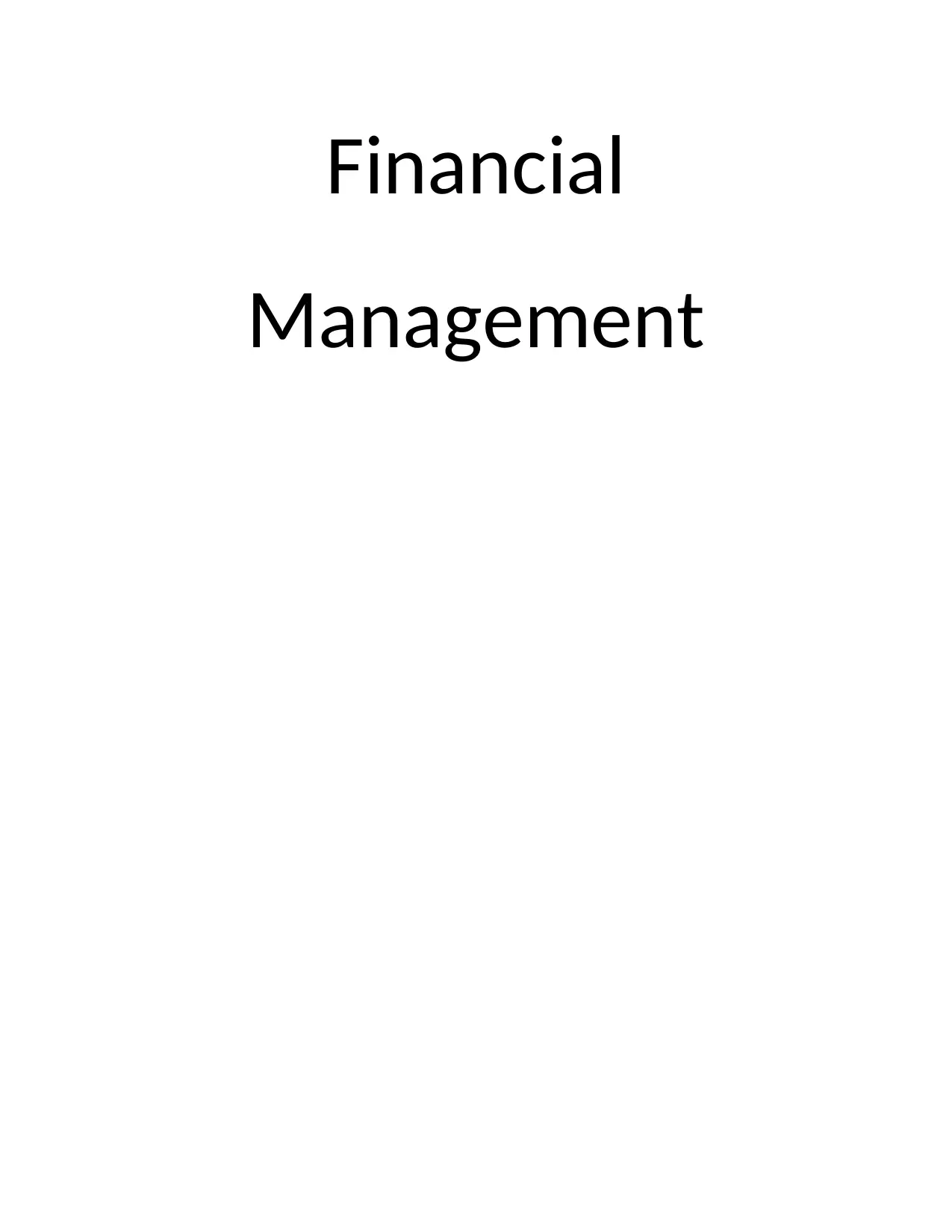
Financial
Management
Management
Paraphrase This Document
Need a fresh take? Get an instant paraphrase of this document with our AI Paraphraser
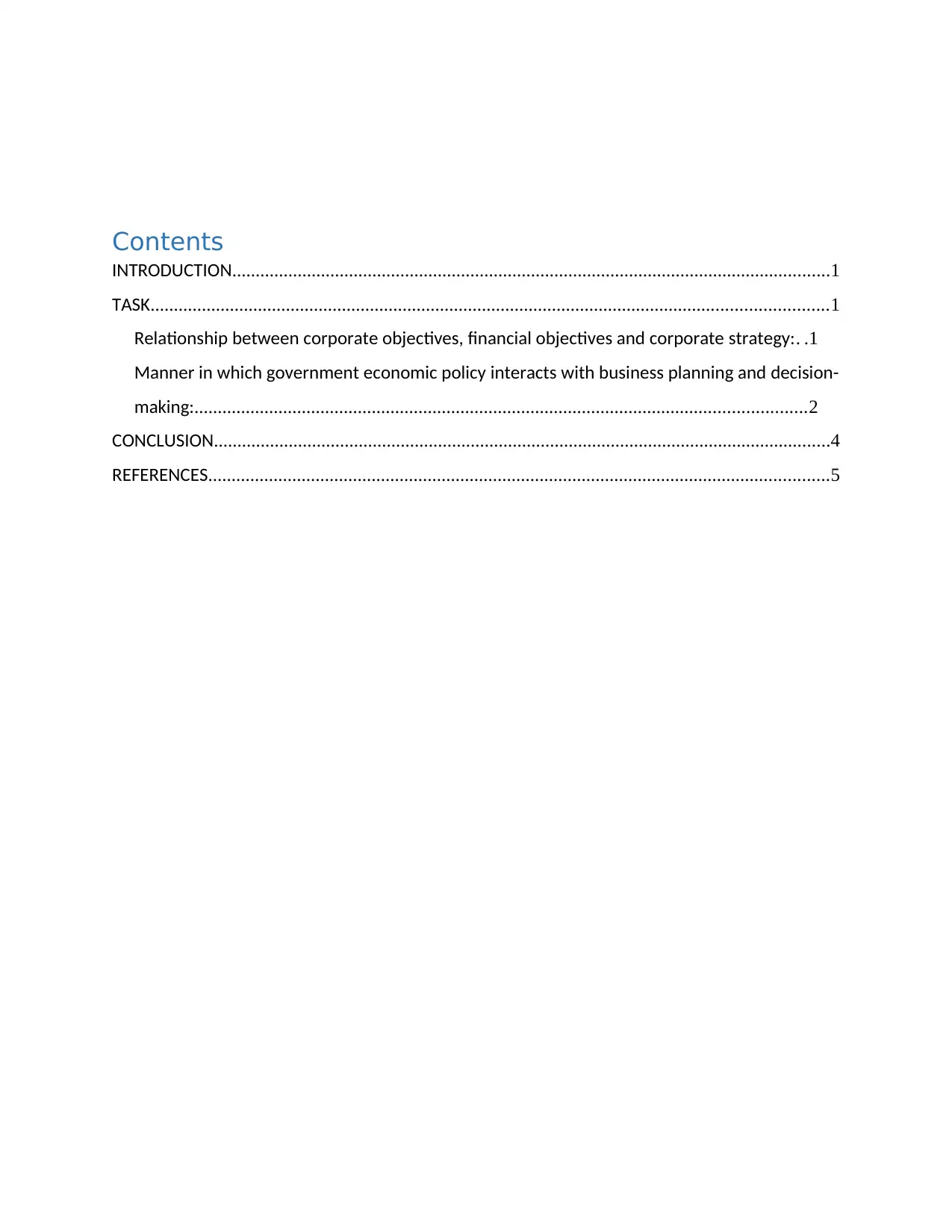
Contents
INTRODUCTION................................................................................................................................1
TASK.................................................................................................................................................1
Relationship between corporate objectives, financial objectives and corporate strategy:. .1
Manner in which government economic policy interacts with business planning and decision-
making:...................................................................................................................................2
CONCLUSION....................................................................................................................................4
REFERENCES.....................................................................................................................................5
INTRODUCTION................................................................................................................................1
TASK.................................................................................................................................................1
Relationship between corporate objectives, financial objectives and corporate strategy:. .1
Manner in which government economic policy interacts with business planning and decision-
making:...................................................................................................................................2
CONCLUSION....................................................................................................................................4
REFERENCES.....................................................................................................................................5
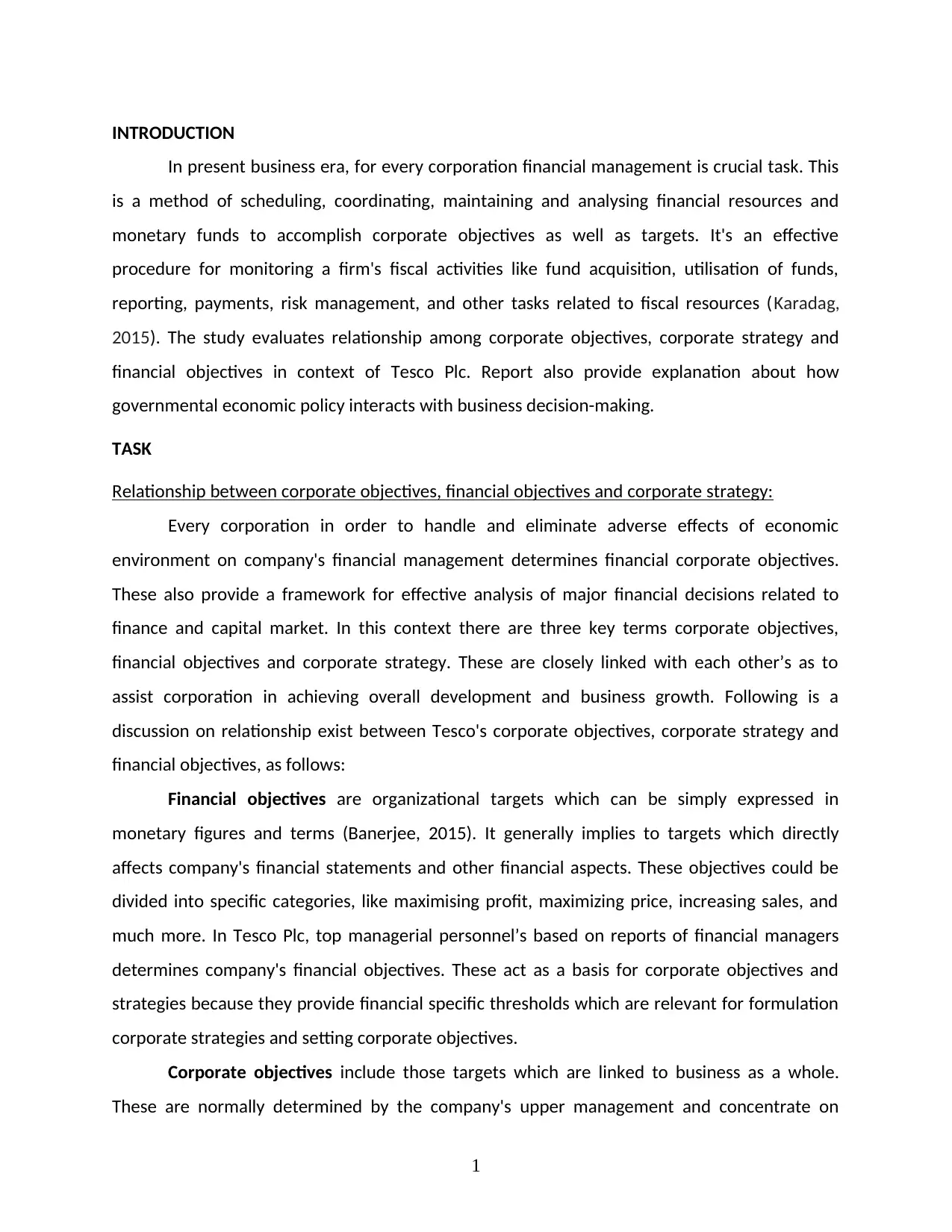
INTRODUCTION
In present business era, for every corporation financial management is crucial task. This
is a method of scheduling, coordinating, maintaining and analysing financial resources and
monetary funds to accomplish corporate objectives as well as targets. It's an effective
procedure for monitoring a firm's fiscal activities like fund acquisition, utilisation of funds,
reporting, payments, risk management, and other tasks related to fiscal resources (Karadag,
2015). The study evaluates relationship among corporate objectives, corporate strategy and
financial objectives in context of Tesco Plc. Report also provide explanation about how
governmental economic policy interacts with business decision-making.
TASK
Relationship between corporate objectives, financial objectives and corporate strategy:
Every corporation in order to handle and eliminate adverse effects of economic
environment on company's financial management determines financial corporate objectives.
These also provide a framework for effective analysis of major financial decisions related to
finance and capital market. In this context there are three key terms corporate objectives,
financial objectives and corporate strategy. These are closely linked with each other’s as to
assist corporation in achieving overall development and business growth. Following is a
discussion on relationship exist between Tesco's corporate objectives, corporate strategy and
financial objectives, as follows:
Financial objectives are organizational targets which can be simply expressed in
monetary figures and terms (Banerjee, 2015). It generally implies to targets which directly
affects company's financial statements and other financial aspects. These objectives could be
divided into specific categories, like maximising profit, maximizing price, increasing sales, and
much more. In Tesco Plc, top managerial personnel’s based on reports of financial managers
determines company's financial objectives. These act as a basis for corporate objectives and
strategies because they provide financial specific thresholds which are relevant for formulation
corporate strategies and setting corporate objectives.
Corporate objectives include those targets which are linked to business as a whole.
These are normally determined by the company's upper management and concentrate on
1
In present business era, for every corporation financial management is crucial task. This
is a method of scheduling, coordinating, maintaining and analysing financial resources and
monetary funds to accomplish corporate objectives as well as targets. It's an effective
procedure for monitoring a firm's fiscal activities like fund acquisition, utilisation of funds,
reporting, payments, risk management, and other tasks related to fiscal resources (Karadag,
2015). The study evaluates relationship among corporate objectives, corporate strategy and
financial objectives in context of Tesco Plc. Report also provide explanation about how
governmental economic policy interacts with business decision-making.
TASK
Relationship between corporate objectives, financial objectives and corporate strategy:
Every corporation in order to handle and eliminate adverse effects of economic
environment on company's financial management determines financial corporate objectives.
These also provide a framework for effective analysis of major financial decisions related to
finance and capital market. In this context there are three key terms corporate objectives,
financial objectives and corporate strategy. These are closely linked with each other’s as to
assist corporation in achieving overall development and business growth. Following is a
discussion on relationship exist between Tesco's corporate objectives, corporate strategy and
financial objectives, as follows:
Financial objectives are organizational targets which can be simply expressed in
monetary figures and terms (Banerjee, 2015). It generally implies to targets which directly
affects company's financial statements and other financial aspects. These objectives could be
divided into specific categories, like maximising profit, maximizing price, increasing sales, and
much more. In Tesco Plc, top managerial personnel’s based on reports of financial managers
determines company's financial objectives. These act as a basis for corporate objectives and
strategies because they provide financial specific thresholds which are relevant for formulation
corporate strategies and setting corporate objectives.
Corporate objectives include those targets which are linked to business as a whole.
These are normally determined by the company's upper management and concentrate on
1
⊘ This is a preview!⊘
Do you want full access?
Subscribe today to unlock all pages.

Trusted by 1+ million students worldwide
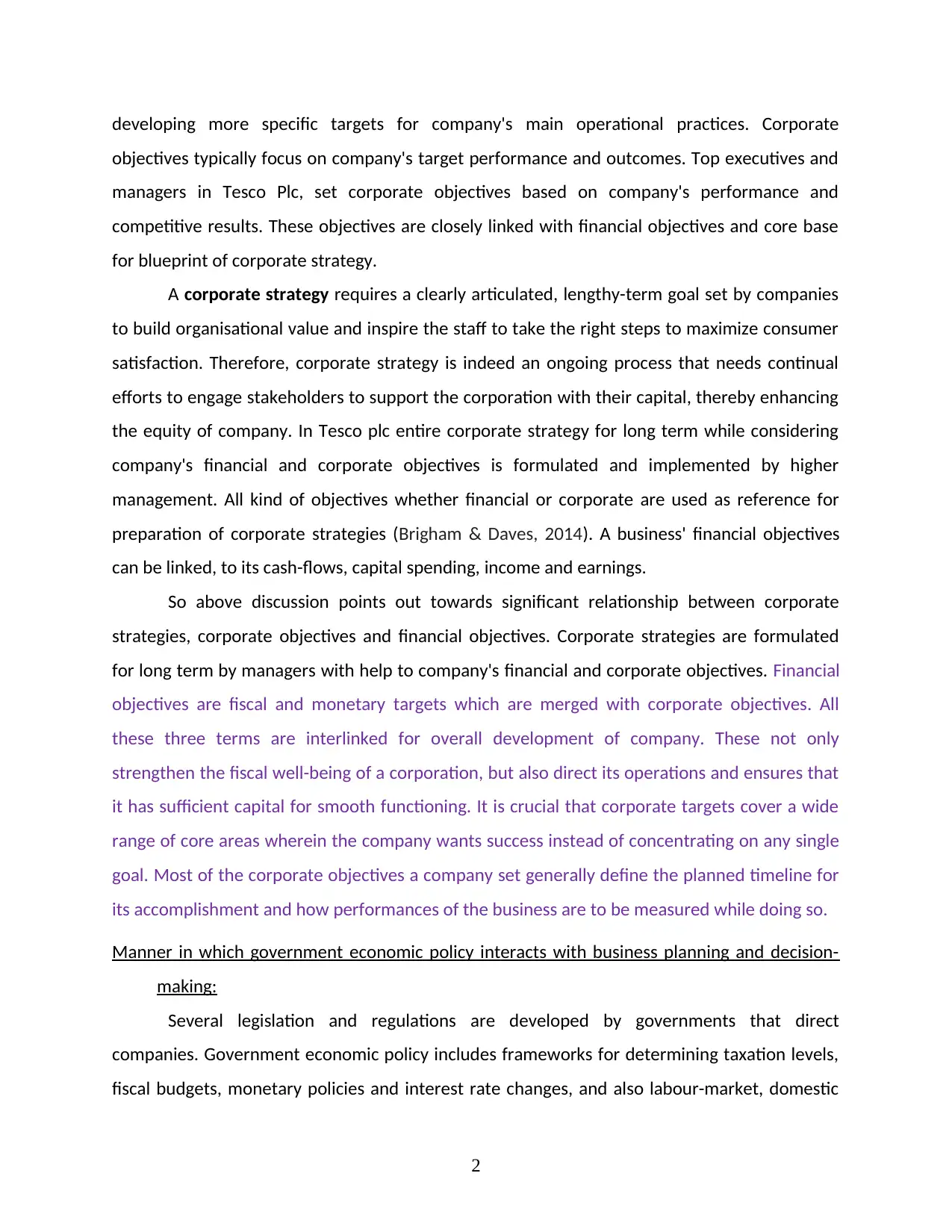
developing more specific targets for company's main operational practices. Corporate
objectives typically focus on company's target performance and outcomes. Top executives and
managers in Tesco Plc, set corporate objectives based on company's performance and
competitive results. These objectives are closely linked with financial objectives and core base
for blueprint of corporate strategy.
A corporate strategy requires a clearly articulated, lengthy-term goal set by companies
to build organisational value and inspire the staff to take the right steps to maximize consumer
satisfaction. Therefore, corporate strategy is indeed an ongoing process that needs continual
efforts to engage stakeholders to support the corporation with their capital, thereby enhancing
the equity of company. In Tesco plc entire corporate strategy for long term while considering
company's financial and corporate objectives is formulated and implemented by higher
management. All kind of objectives whether financial or corporate are used as reference for
preparation of corporate strategies (Brigham & Daves, 2014). A business' financial objectives
can be linked, to its cash-flows, capital spending, income and earnings.
So above discussion points out towards significant relationship between corporate
strategies, corporate objectives and financial objectives. Corporate strategies are formulated
for long term by managers with help to company's financial and corporate objectives. Financial
objectives are fiscal and monetary targets which are merged with corporate objectives. All
these three terms are interlinked for overall development of company. These not only
strengthen the fiscal well-being of a corporation, but also direct its operations and ensures that
it has sufficient capital for smooth functioning. It is crucial that corporate targets cover a wide
range of core areas wherein the company wants success instead of concentrating on any single
goal. Most of the corporate objectives a company set generally define the planned timeline for
its accomplishment and how performances of the business are to be measured while doing so.
Manner in which government economic policy interacts with business planning and decision-
making:
Several legislation and regulations are developed by governments that direct
companies. Government economic policy includes frameworks for determining taxation levels,
fiscal budgets, monetary policies and interest rate changes, and also labour-market, domestic
2
objectives typically focus on company's target performance and outcomes. Top executives and
managers in Tesco Plc, set corporate objectives based on company's performance and
competitive results. These objectives are closely linked with financial objectives and core base
for blueprint of corporate strategy.
A corporate strategy requires a clearly articulated, lengthy-term goal set by companies
to build organisational value and inspire the staff to take the right steps to maximize consumer
satisfaction. Therefore, corporate strategy is indeed an ongoing process that needs continual
efforts to engage stakeholders to support the corporation with their capital, thereby enhancing
the equity of company. In Tesco plc entire corporate strategy for long term while considering
company's financial and corporate objectives is formulated and implemented by higher
management. All kind of objectives whether financial or corporate are used as reference for
preparation of corporate strategies (Brigham & Daves, 2014). A business' financial objectives
can be linked, to its cash-flows, capital spending, income and earnings.
So above discussion points out towards significant relationship between corporate
strategies, corporate objectives and financial objectives. Corporate strategies are formulated
for long term by managers with help to company's financial and corporate objectives. Financial
objectives are fiscal and monetary targets which are merged with corporate objectives. All
these three terms are interlinked for overall development of company. These not only
strengthen the fiscal well-being of a corporation, but also direct its operations and ensures that
it has sufficient capital for smooth functioning. It is crucial that corporate targets cover a wide
range of core areas wherein the company wants success instead of concentrating on any single
goal. Most of the corporate objectives a company set generally define the planned timeline for
its accomplishment and how performances of the business are to be measured while doing so.
Manner in which government economic policy interacts with business planning and decision-
making:
Several legislation and regulations are developed by governments that direct
companies. Government economic policy includes frameworks for determining taxation levels,
fiscal budgets, monetary policies and interest rate changes, and also labour-market, domestic
2
Paraphrase This Document
Need a fresh take? Get an instant paraphrase of this document with our AI Paraphraser
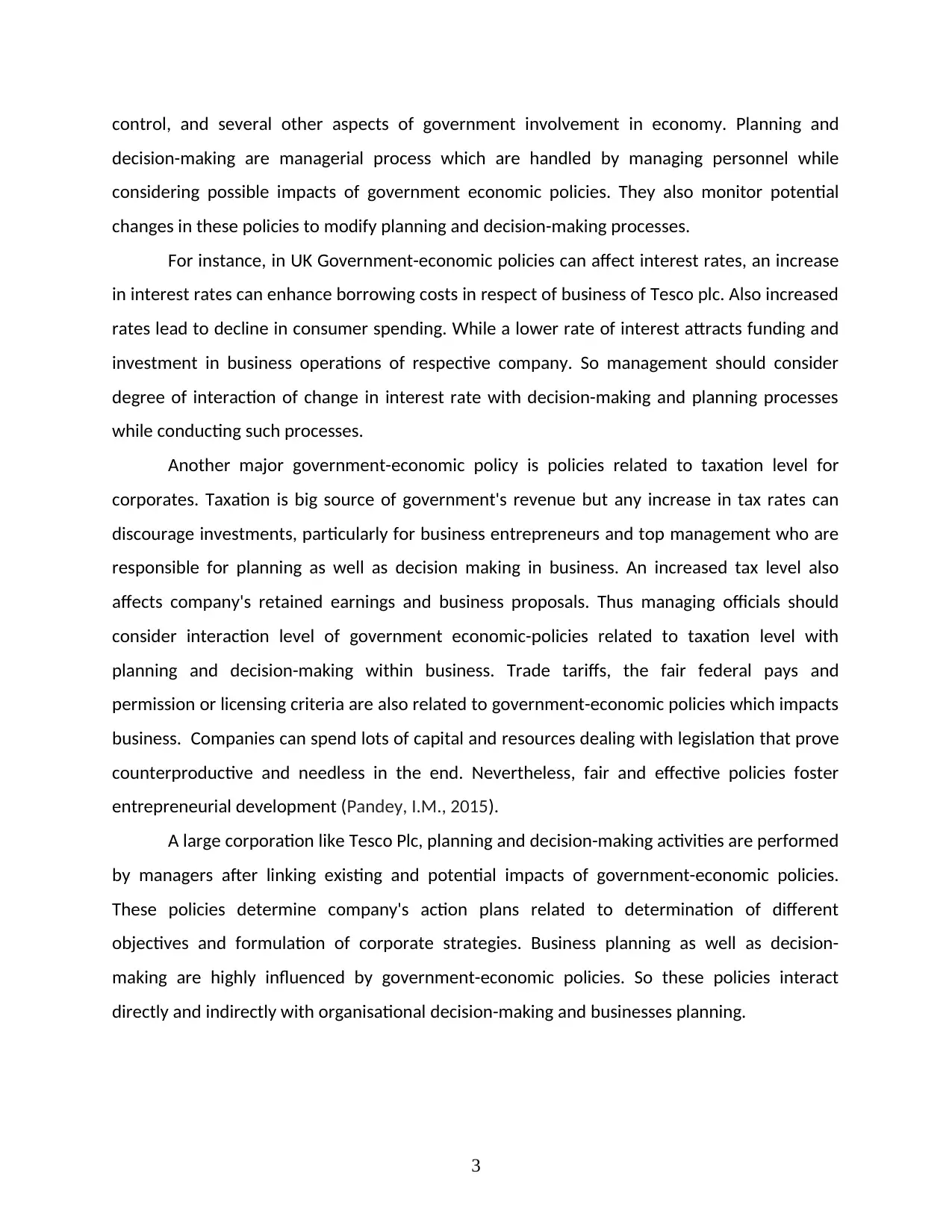
control, and several other aspects of government involvement in economy. Planning and
decision-making are managerial process which are handled by managing personnel while
considering possible impacts of government economic policies. They also monitor potential
changes in these policies to modify planning and decision-making processes.
For instance, in UK Government-economic policies can affect interest rates, an increase
in interest rates can enhance borrowing costs in respect of business of Tesco plc. Also increased
rates lead to decline in consumer spending. While a lower rate of interest attracts funding and
investment in business operations of respective company. So management should consider
degree of interaction of change in interest rate with decision-making and planning processes
while conducting such processes.
Another major government-economic policy is policies related to taxation level for
corporates. Taxation is big source of government's revenue but any increase in tax rates can
discourage investments, particularly for business entrepreneurs and top management who are
responsible for planning as well as decision making in business. An increased tax level also
affects company's retained earnings and business proposals. Thus managing officials should
consider interaction level of government economic-policies related to taxation level with
planning and decision-making within business. Trade tariffs, the fair federal pays and
permission or licensing criteria are also related to government-economic policies which impacts
business. Companies can spend lots of capital and resources dealing with legislation that prove
counterproductive and needless in the end. Nevertheless, fair and effective policies foster
entrepreneurial development (Pandey, I.M., 2015).
A large corporation like Tesco Plc, planning and decision-making activities are performed
by managers after linking existing and potential impacts of government-economic policies.
These policies determine company's action plans related to determination of different
objectives and formulation of corporate strategies. Business planning as well as decision-
making are highly influenced by government-economic policies. So these policies interact
directly and indirectly with organisational decision-making and businesses planning.
3
decision-making are managerial process which are handled by managing personnel while
considering possible impacts of government economic policies. They also monitor potential
changes in these policies to modify planning and decision-making processes.
For instance, in UK Government-economic policies can affect interest rates, an increase
in interest rates can enhance borrowing costs in respect of business of Tesco plc. Also increased
rates lead to decline in consumer spending. While a lower rate of interest attracts funding and
investment in business operations of respective company. So management should consider
degree of interaction of change in interest rate with decision-making and planning processes
while conducting such processes.
Another major government-economic policy is policies related to taxation level for
corporates. Taxation is big source of government's revenue but any increase in tax rates can
discourage investments, particularly for business entrepreneurs and top management who are
responsible for planning as well as decision making in business. An increased tax level also
affects company's retained earnings and business proposals. Thus managing officials should
consider interaction level of government economic-policies related to taxation level with
planning and decision-making within business. Trade tariffs, the fair federal pays and
permission or licensing criteria are also related to government-economic policies which impacts
business. Companies can spend lots of capital and resources dealing with legislation that prove
counterproductive and needless in the end. Nevertheless, fair and effective policies foster
entrepreneurial development (Pandey, I.M., 2015).
A large corporation like Tesco Plc, planning and decision-making activities are performed
by managers after linking existing and potential impacts of government-economic policies.
These policies determine company's action plans related to determination of different
objectives and formulation of corporate strategies. Business planning as well as decision-
making are highly influenced by government-economic policies. So these policies interact
directly and indirectly with organisational decision-making and businesses planning.
3
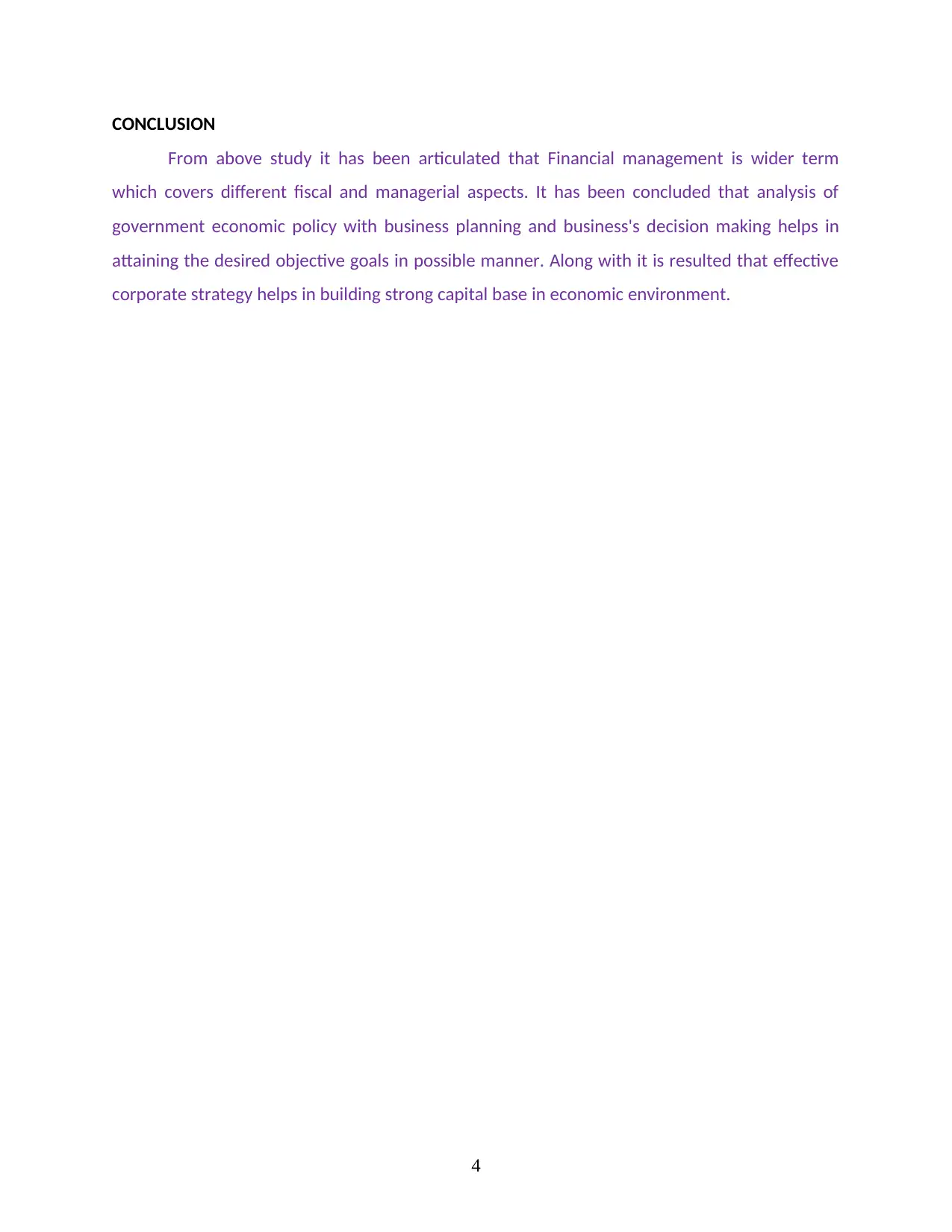
CONCLUSION
From above study it has been articulated that Financial management is wider term
which covers different fiscal and managerial aspects. It has been concluded that analysis of
government economic policy with business planning and business's decision making helps in
attaining the desired objective goals in possible manner. Along with it is resulted that effective
corporate strategy helps in building strong capital base in economic environment.
4
From above study it has been articulated that Financial management is wider term
which covers different fiscal and managerial aspects. It has been concluded that analysis of
government economic policy with business planning and business's decision making helps in
attaining the desired objective goals in possible manner. Along with it is resulted that effective
corporate strategy helps in building strong capital base in economic environment.
4
⊘ This is a preview!⊘
Do you want full access?
Subscribe today to unlock all pages.

Trusted by 1+ million students worldwide
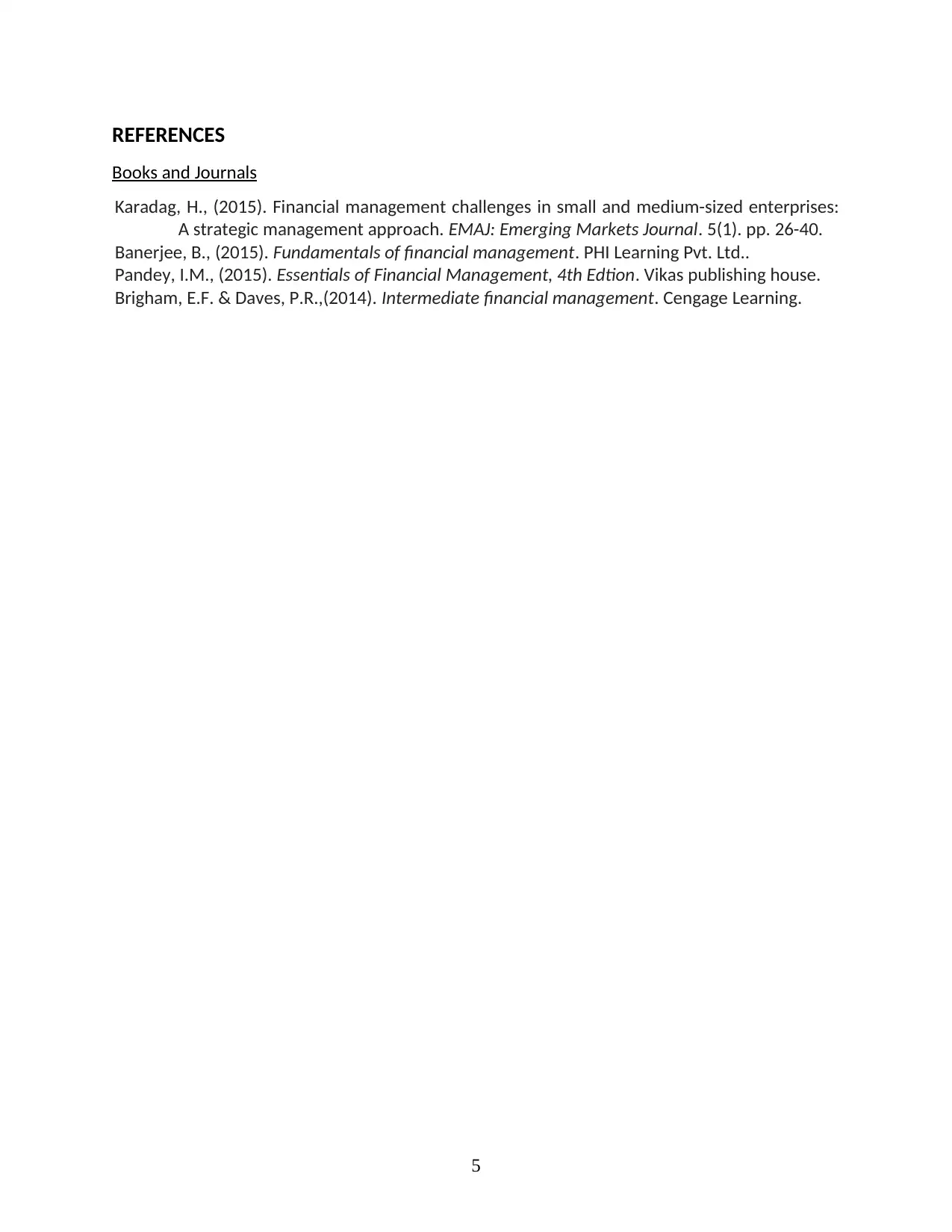
REFERENCES
Books and Journals
Karadag, H., (2015). Financial management challenges in small and medium-sized enterprises:
A strategic management approach. EMAJ: Emerging Markets Journal. 5(1). pp. 26-40.
Banerjee, B., (2015). Fundamentals of financial management. PHI Learning Pvt. Ltd..
Pandey, I.M., (2015). Essentials of Financial Management, 4th Edtion. Vikas publishing house.
Brigham, E.F. & Daves, P.R.,(2014). Intermediate financial management. Cengage Learning.
5
Books and Journals
Karadag, H., (2015). Financial management challenges in small and medium-sized enterprises:
A strategic management approach. EMAJ: Emerging Markets Journal. 5(1). pp. 26-40.
Banerjee, B., (2015). Fundamentals of financial management. PHI Learning Pvt. Ltd..
Pandey, I.M., (2015). Essentials of Financial Management, 4th Edtion. Vikas publishing house.
Brigham, E.F. & Daves, P.R.,(2014). Intermediate financial management. Cengage Learning.
5
1 out of 7
Related Documents
Your All-in-One AI-Powered Toolkit for Academic Success.
+13062052269
info@desklib.com
Available 24*7 on WhatsApp / Email
![[object Object]](/_next/static/media/star-bottom.7253800d.svg)
Unlock your academic potential
Copyright © 2020–2025 A2Z Services. All Rights Reserved. Developed and managed by ZUCOL.




